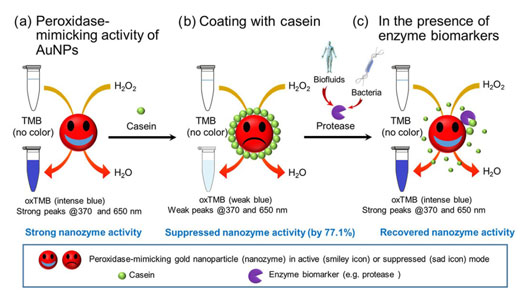
hotline:
17715390137
Tel/Wechat:
18101240246 (Technology)
0512-68565571
Email:mxenes@163.com (Sales Engineer)bkxc.bonnie@gmail.com
Scan the code to follow or search the official account on WeChat:
2D Materials Fronrier After paying attention,
click on the lower right corner to contact us,
Enter enterprise WeChat.
Professional Services Online

| Nanoparticles that mimic the complexity and function of natural enzymes can act as effective peroxidases, catalyzing the oxidation of 3,3 ‘, 5‘5-tetramethylbenzidine (TMB) to produce oxidized blue products. | |
| For the first time, scientists at the Institute of Global Food Safety at Queen‘s University Belfast found that when the surface of gold nanoparticles (AuNPs) was coated with casein, the intrinsic peroxidase mimicking activity of AuNPs was strongly inhibited, ie, up to 77.1%. Attributed to surface shielding. | |
| However, in the presence of a protease, the casein shield is degraded, allowing the peroxidase mimicking activity of AuNP to be restored, thereby detecting proteolytic enzymes. | |
| Proteases are involved in all life functions, highlighting their key role in the progression of many diseases and microbial growth. Conventional methods for protease detection are slow, lack the sensitivity required for low-level detection, and cannot be used in the field. These limitations prevent the application of these detection methods and cannot provide early signs of food spoilage, infection and disease status. | |
| To overcome these limitations, Dr. Cuong Cao‘s research team at the Institute of Global Food Safety at Queen‘s University Belfast has developed a simplified method that takes advantage of the properties of gold nanoparticles. | |
| The results highlight a sensitive, fast, and cost-effective nanosensor for protease detection in milk and urine. This recent work in the Nano Research, ( "for determining biomarker protein hydrolyzate peroxidase simulations of switchable nano enzyme" on) released in the form of OA. | |

|
|
| The overall protocol demonstrated that the conversion of peroxidase mimicking activity of casein-coated AuNPs was used to detect enzyme biomarkers. (A) AuNP has the peroxidase simulation ability to catalyze the oxidation of TMB in the presence of H 2 O 2 , causing oxTMB to appear blue and strongly absorb light at 370 and 650 nm. (B) When casein is coated on the surface of AuNP, the peroxidase mimicking activity is inhibited, resulting in a decrease in absorption at 370 and 650 nm. (C) In the presence of proteases derived from biological fluids or microorganisms, the hydrolytic cleavage of the surface shielding layer (casein) results in the restoration of the peroxidase mimicking activity of AuNP. (© Springer) (click image to enlarge) | |
| To create the nanosensor, the researchers first determined that AuNPs could mimic the behavior of natural enzymes under predetermined conditions, namely peroxidase that can accelerate the oxidation of 3,3 ‘, 5‘5-tetramethylbenzidine (TMB). A blue product that strongly absorbs 370 nm and 650 nm light and is clearly visible to the naked eye. | |
| Interestingly, the researchers also found that this behavior can be adjusted to suit the intended application. | |
| To develop this discovery into a protease detection method, AuNPs are coated with casein, a protein that is basically found in milk, and its ability to inhibit enzyme mimicry is 77.1%. | |
| The reduction is due to the casein molecule blocking the surface reaction, which means that the reaction occurs much more slowly (without forming a vivid blue). | |
| Importantly, casein also acts as a substrate for protease digestion, and due to its restoration to mimic the behavior of the enzyme, it is removed from the surface of AuNP and subsequently forms a vivid blue color. | |
| The researchers also suggest using the peak absorbance at 370 nm to quantify the peroxidase mimicking activity of AuNPs. This is because in a medium with a high electrolyte content, AuNP aggregation can be induced, resulting in a red shift of the plasmon peak around 650-700 nm. | |
| Therefore, the absorption peak at 650 nm is less useful in this method due to the potential overlap of the aggregation peaks of the nanoparticles. This finding provides important insights into the peroxidase mimicking activity of AuNPs. | |
| With this method, no complicated or expensive reading equipment is required to obtain results in 90 minutes. The method is used for milk and urine analysis and shows promise as a food safety and disease screening tool. | |
|
Importantly, coating different molecules on the surface of AuNP has the potential to extend detection capabilities beyond proteolytic enzymes. Source: Nanowerk |

| Reminder: Beijing Beike New Material Technology Co., Ltd. supplies products only for scientific research, not for humans |
| All rights reserved © 2019 beijing beike new material Technology Co., Ltd 京ICP备16054715-2号 |